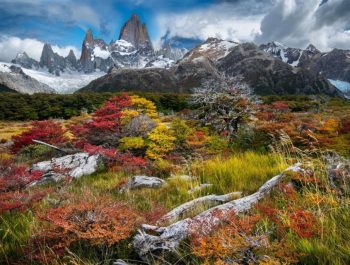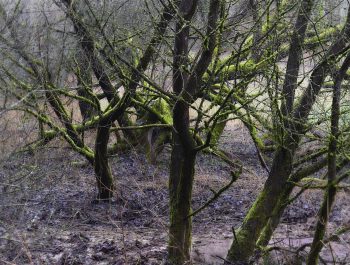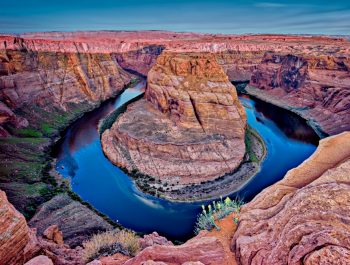Photographing Wildlife in Bosque del Apache, NM
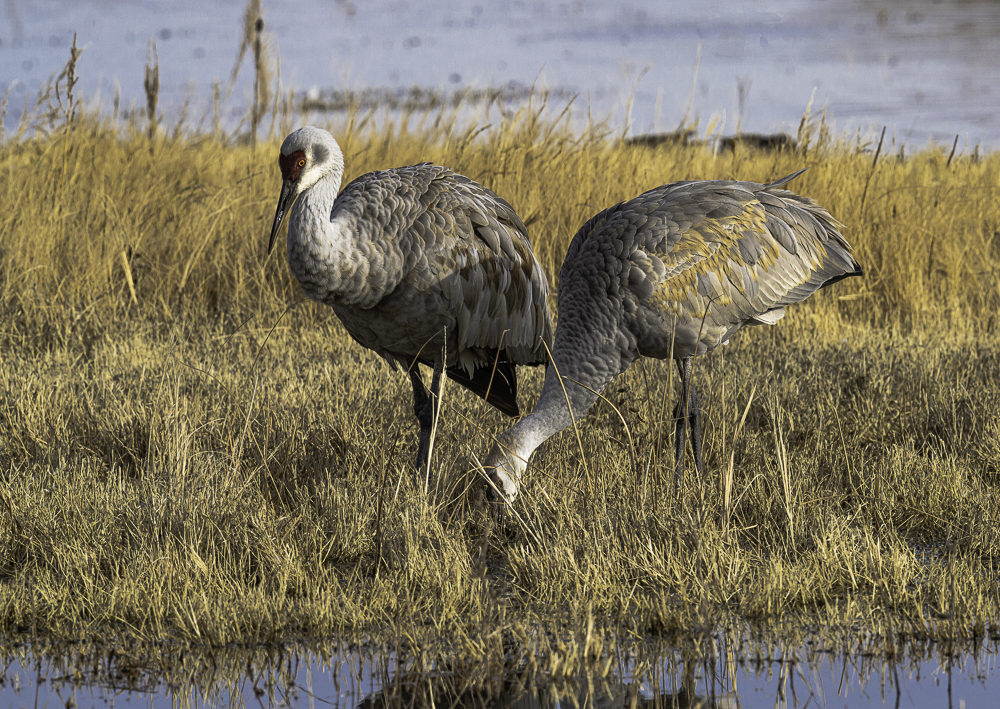
There are wildlife migrations in almost every corner of the world. Inevitably, migrations result from the need for herds, flocks, fish and other wildlife concentrations to follow shifting seasonal weather patterns that affect food supply and breeding. Even among insects, there is the Monarch Butterfly that migrates thousands of miles every year, although in this case, it takes more than one generation to complete the round trip.
Among North American migrations today, bird migrations are arguably the most spectacular of all. Collectively, they involve millions of ducks, geese, cranes and other waterfowl that make annual round trips of 5,000 to as much as 8,000 miles, from breeding grounds in the northern United States, Canada, and Alaska to wintering grounds in the southern United States and in Mexico.
Sandhill Cranes
The annual Sandhill Crane migrations occur within two major flyways known as the Western and the Central Flyways. The annual cycle initiates with adults and their young leaving their breeding grounds in Alaska, Canada, Michigan and Minnesota in Autumn and migrating south toward Mexico. A small fraction may remain in the southernmost Portions of Texas, New Mexico, and Arizona before beginning their northward return journey in March and April.
The two legs of the cycle are different. The Fall migration is more spread out geographically and over time, while in the Spring, these birds are in more of a hurry to get to their breeding grounds. Consequently, they take the most direct route, stop at fewer locations, and concentrate along the Platte River in Nebraska, where over 500,000 cranes gather for several weeks to rest before completing the rest of the northward journey. Ironically, crane photography in the Spring in Nebraska is not easy because there are very few access points along the Platte that allow unimpeded close-up views of the birds. In the West, crane photography is often at its best at the Bosque del Apache Federal Wildlife Preserve in Southern New Mexico, even though only 6,000 to 8,000 cranes winter there now. This preserve allows for close proximity to the cranes and also hosts other migratory birds, as well as resident birds and mammals.
Because of the above considerations, I scheduled a trip to Bosque del Apache (BDA) for the third week of November 2019, during the Crane Festival, to meet up with three photographer friends from Colorado, Minnesota, and Washington State. My Colorado friend has photographed cranes in Nebraska, while my Minnesota friend photographed cranes near his home, and had photographed them several times in BDA as well. Cranes are also found in Washington where my third friend lives.
As for me, I had last been to BDA in 2005 and photographed Canada Geese, Blue Herons, Egrets, and Glossy Ibis, but not cranes, as I was there in May. Despite our varied experience, we were all equally excited to make this trip.
This may sound like a lot of fuss to some people. However, cranes are majestic birds reaching five feet high and weighing as much as 14 pounds. They have large bodies, long necks and legs, and their wingspan reaches seven feet. Their coloring includes red headcaps, orange eyes and blue-gray plumage that is often stained brown in spots from grooming their feathers with mud-covered bills. They are very social and maintain constant chatter consisting of purring noises, chirps, and bugles. Some calls are designed to attract friends to their location. Others occur during territorial squabbles, and others used in mating rituals when males and females synchronize both movements and sounds. Overall, Cranes are colorful and photogenic.
Cranes are also strong fliers that can reach 28,000 feet and ride thermals with little effort. They have been known to fly 500 miles in a single day.
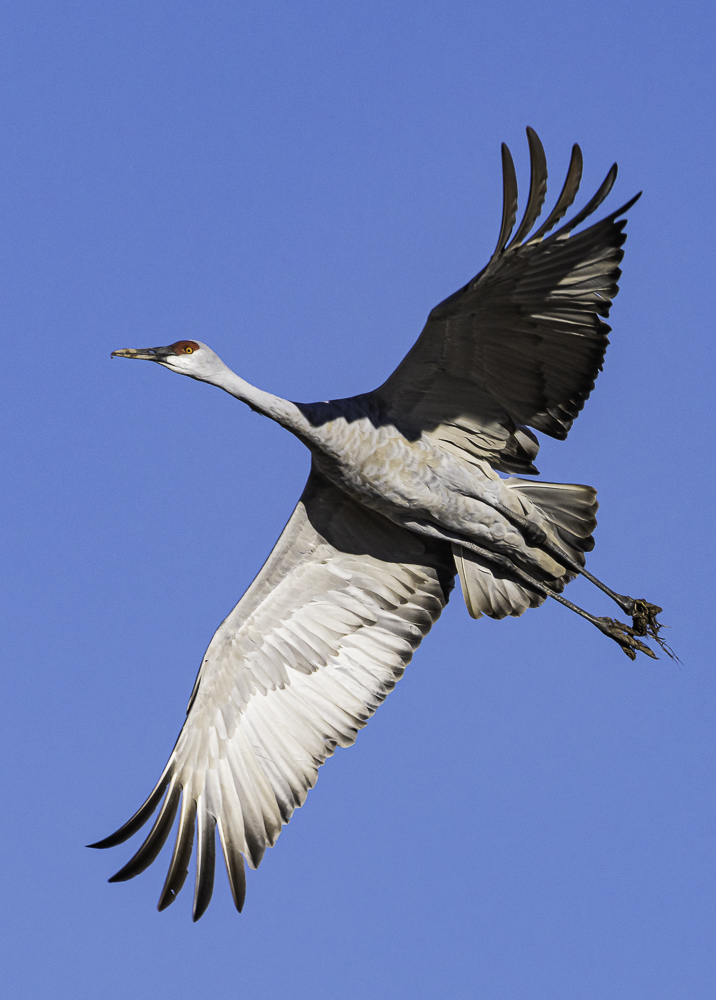
Though generally sociable and self-controlled, they have periodic territorial disputes that usually get resolved after short bouts of wing-flapping, jumping and squawking.
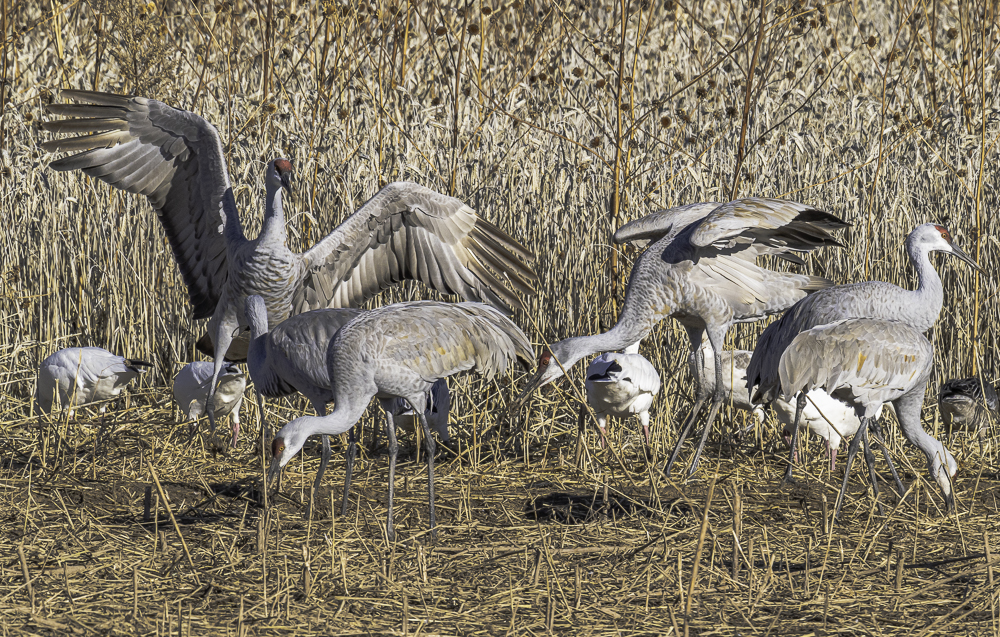
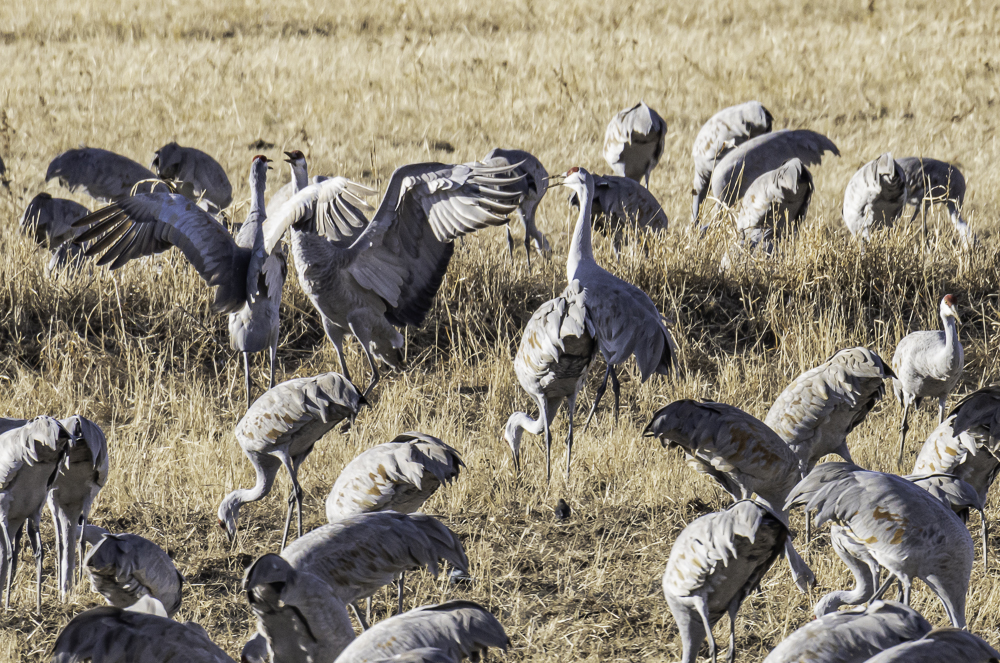
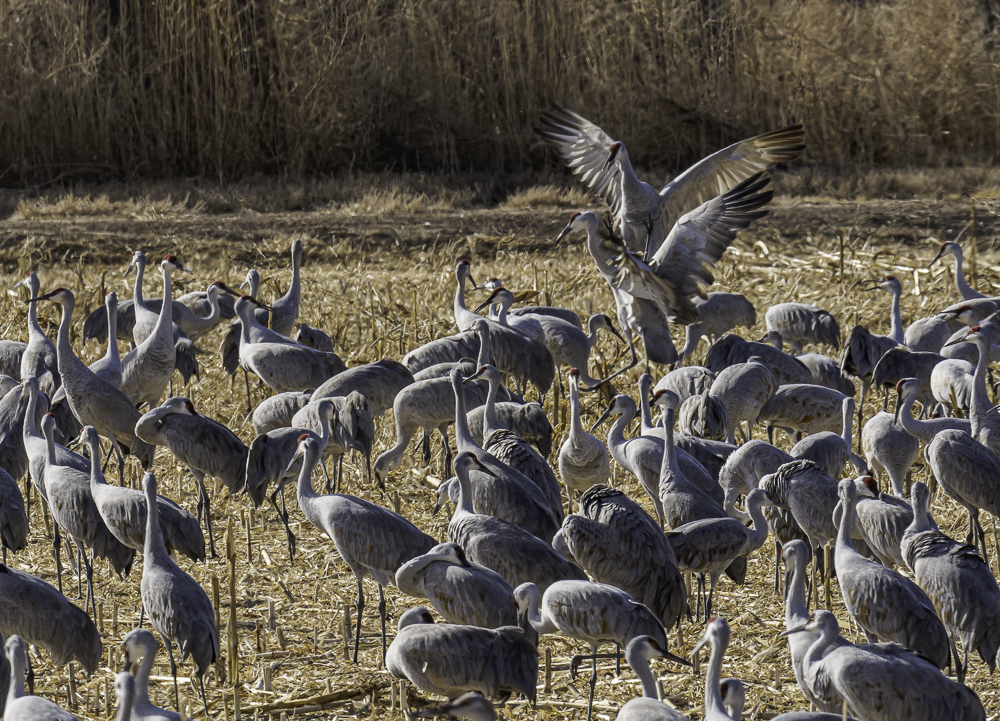
From November to mid-March, U.S. Wildlife management floods some fields to provide protection for the cranes at night. The cranes fly to the flooded areas every evening and sleep surrounded by water and safe from predators. At sunrise they fly off to the dryer fields to search for a variety of foods that includes insects, worms, green shoots, and even field mice. The locally farmed grain is dispersed to supplement the diets of visiting waterfowl.
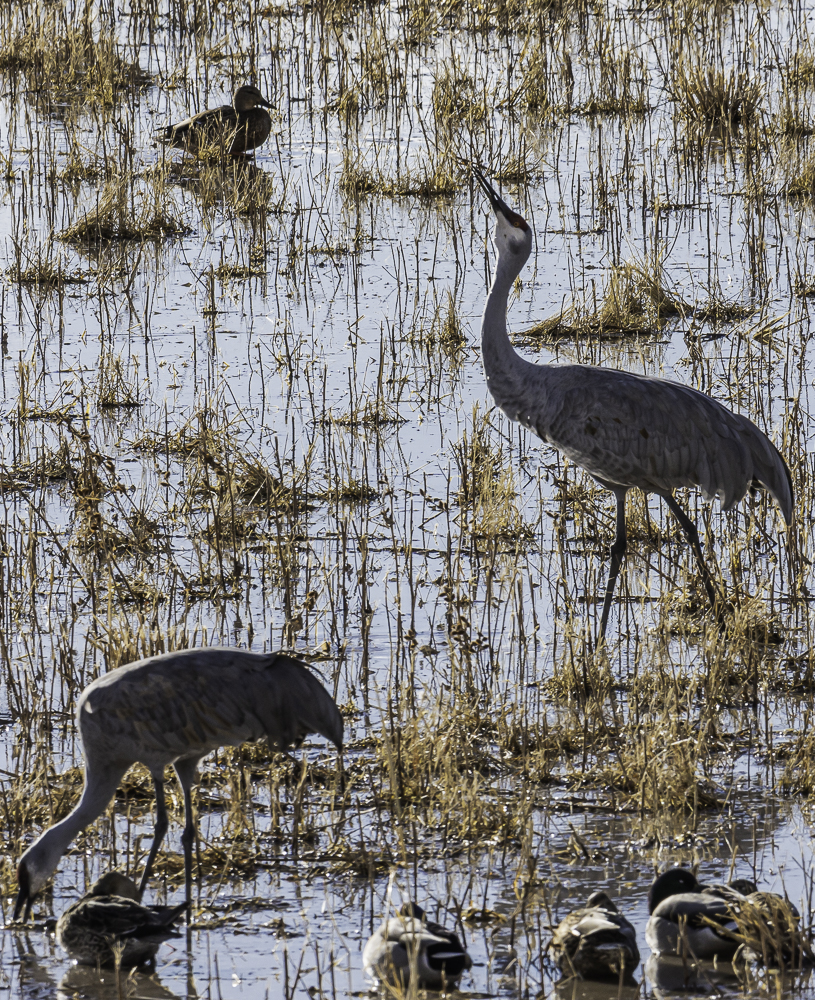
Adding to the fun of photographing cranes is their group dynamics and postures that often elicit humorous anthropomorphic interpretation, as in the case of the next two images.
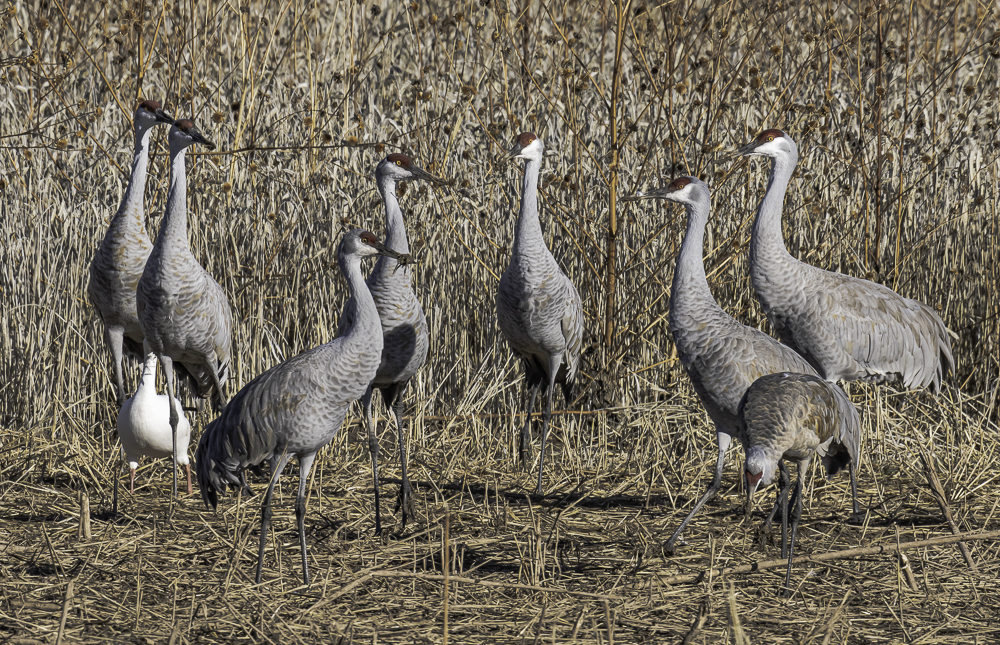
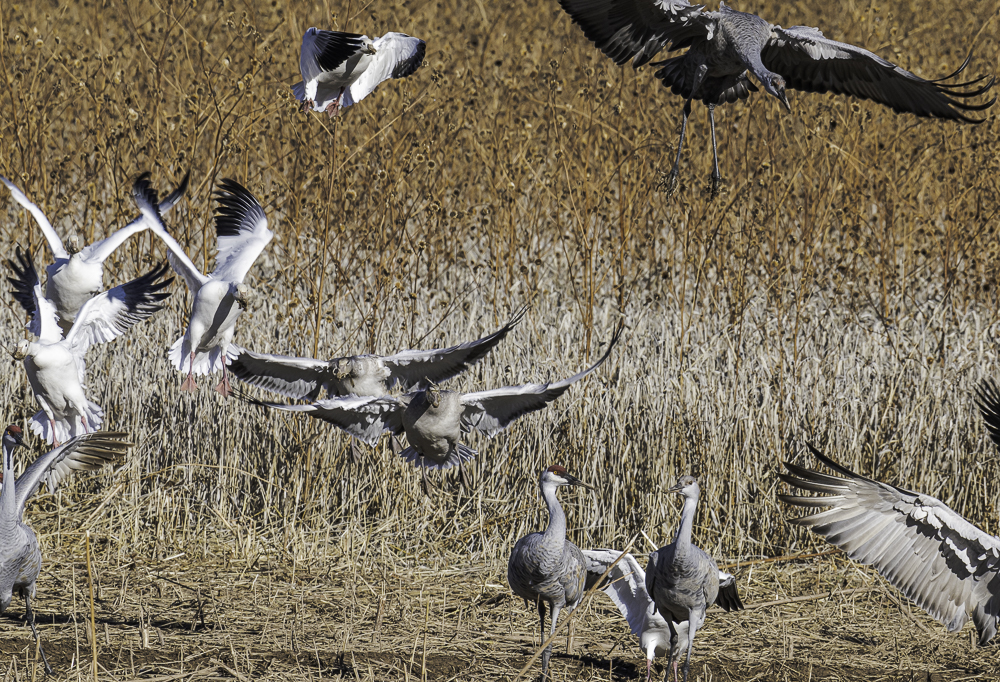
There are also large quantities of other migratory birds worth photographing at BDA.
Snow Geese
Snow Geese resemble domesticated white geese, except that the tips of their under-wings are black. They are found all over North America. But, like cranes, their breeding grounds are in the northern latitudes even beyond the Arctic Circle. They are very compatible with the cranes and share migration routes and stopovers. They readily mingle with cranes in concentrated groups during daytime feeding activity, though they tend to be exclusive when floating in the water. Their fly-off behavior is most likely the reason for this.
Snow Geese will mass together on the ground and on ponds and marshes. Like the cranes, they will take off in the morning in search of food. But, whereas the cranes take off in a series of small groups of four, five and six birds at a time, Snow Geese will seemingly erupt in one huge mass. The differences in body size and a wingspan between the two species makes their differences in take-off behavior totally logical. The cranes need much more space as they cannot react as quickly to avoid mid-air collisions. They’re built to cruise at high altitudes. But, take-offs are slow and relatively awkward. The Snow Geese seem to have no difficulty reacting quickly and maneuvering despite the astonishing density of the flocks during the first five seconds of chaotic flight. This characteristic alone makes them highly photogenic.
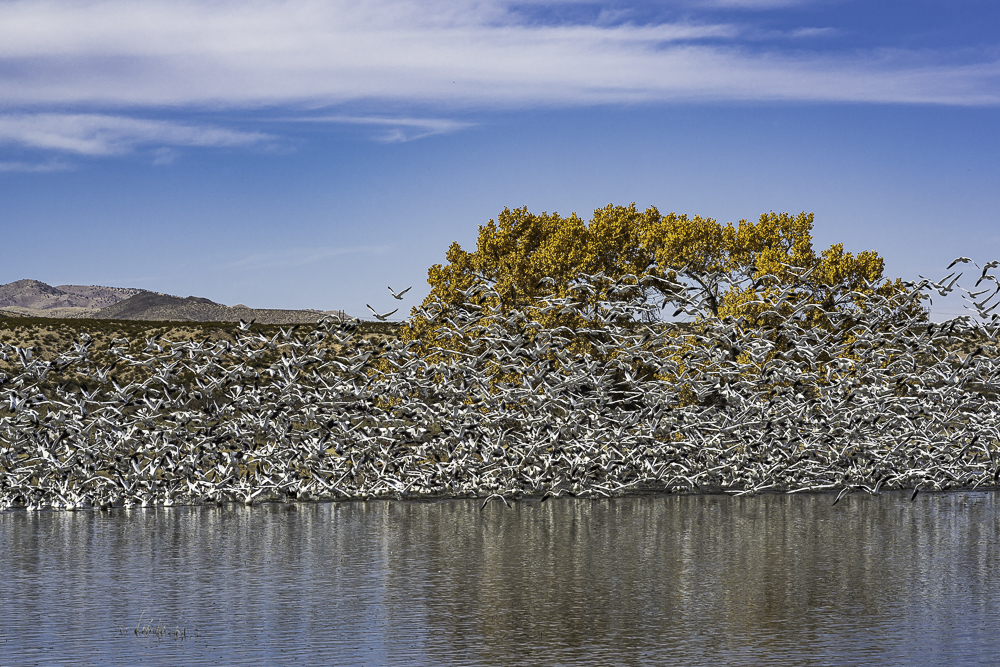
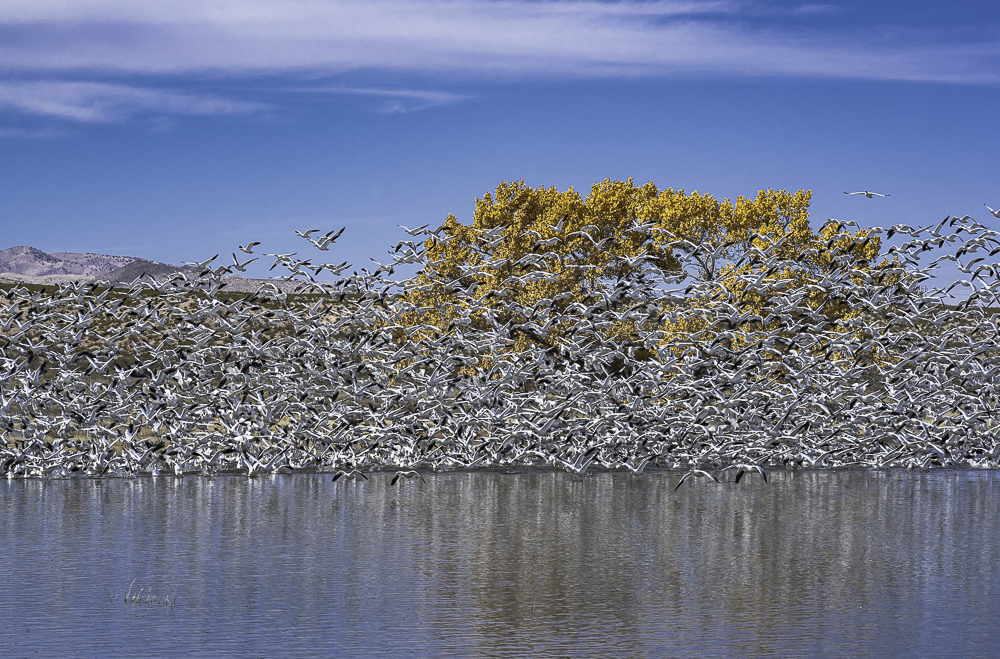
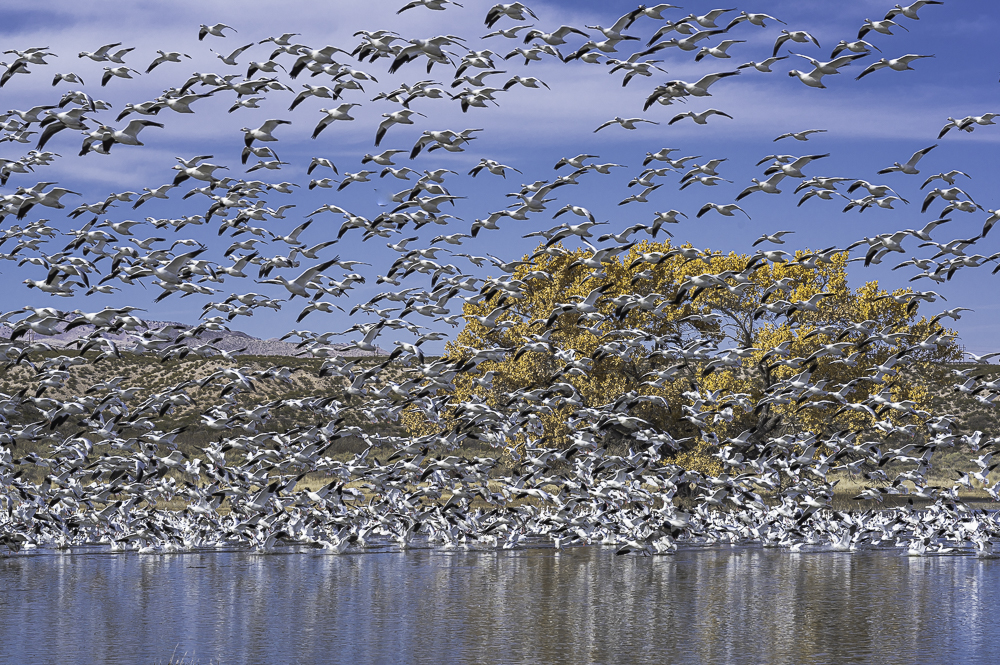
The above sequence is repeated throughout the day in different parts of the Preserve: at sunrise, when changing feeding areas, and at sunset when the geese leave for the ponds and marshes to sleep. And because there usually are ten thousand to twenty thousand Snow Geese in the Preserve in late Autumn, there are many mass take-offs throughout the north loop of BDA.
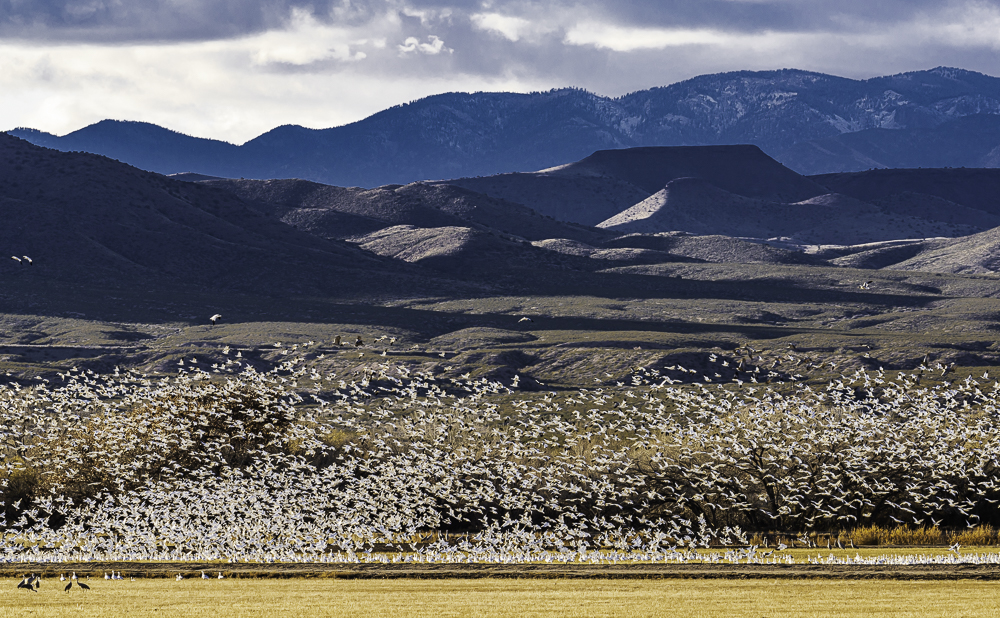
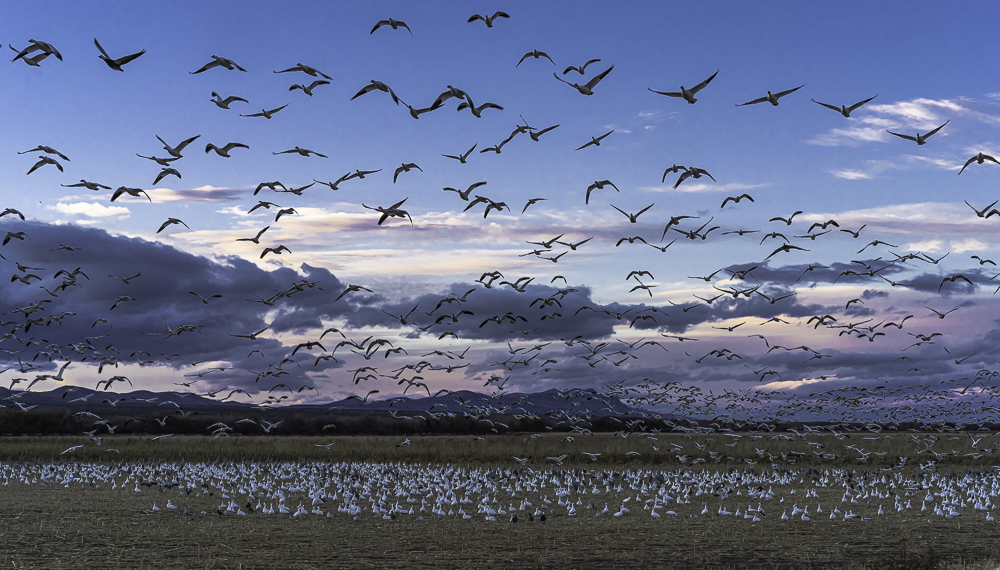
Other Birds at BDA
Many varieties of birds visit BDA throughout the year, and are worth observing and photographing. During my recent trip, I photographed Canada Geese and a Northern Harrier (belonging to the Hawk Family).
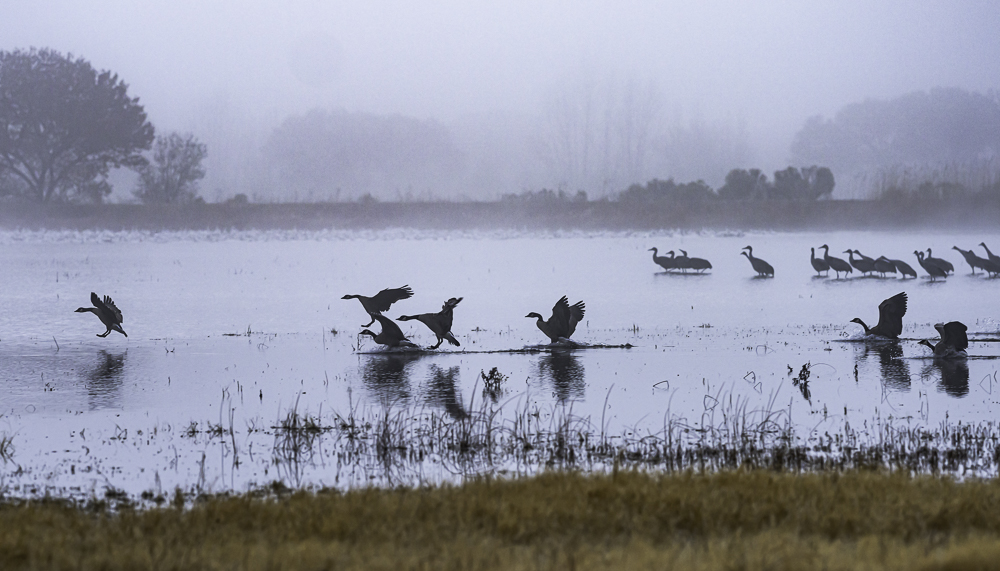
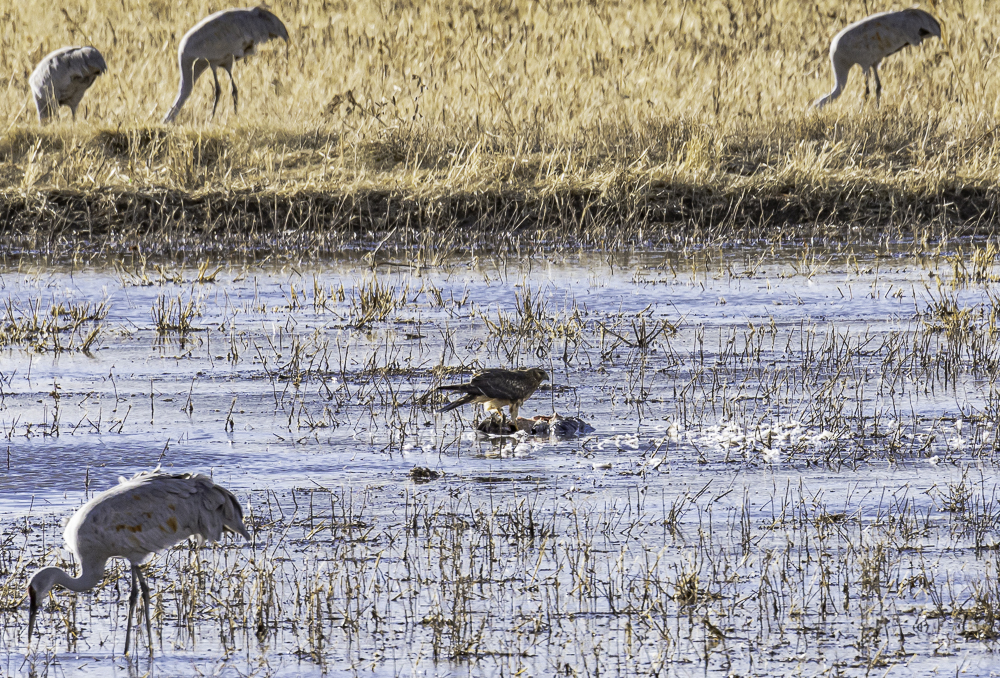
During my first trip to BDA in May of 2005, I photographed Great Blue Herons, Egrets, Glossy Ibis, and a mated pair of Canada Geese with seven chicks. The Glossy Ibis apparently migrated from Florida through Texas to BDA, and are not often seen in the Southwest.
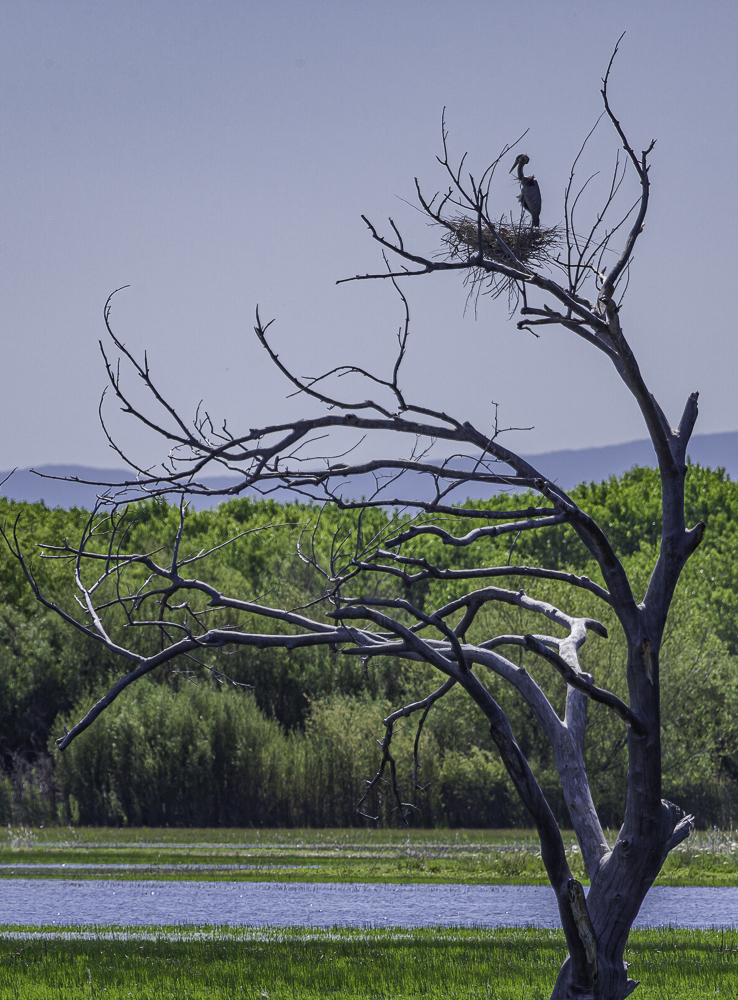
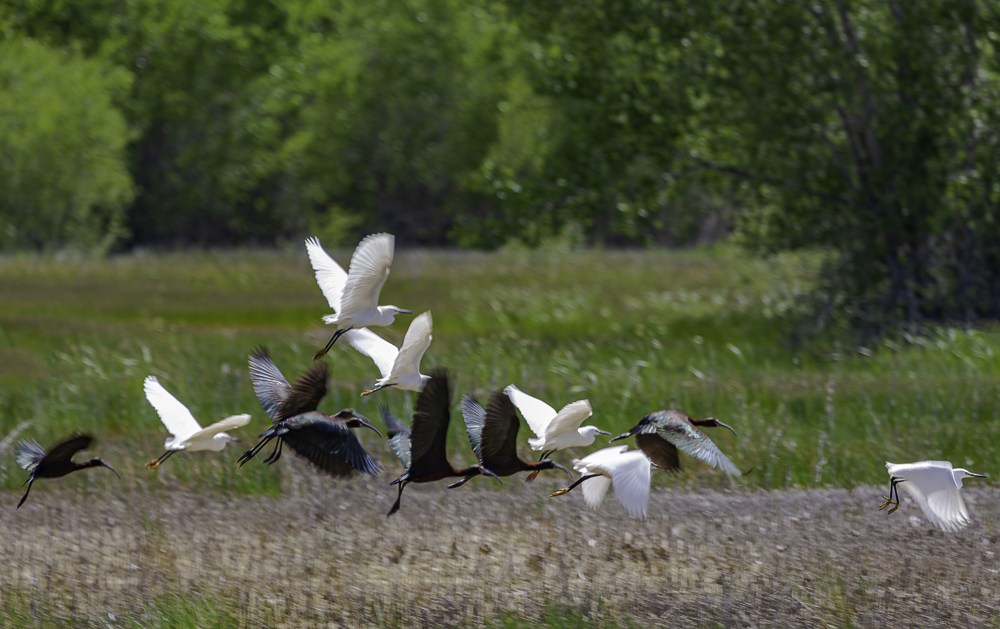
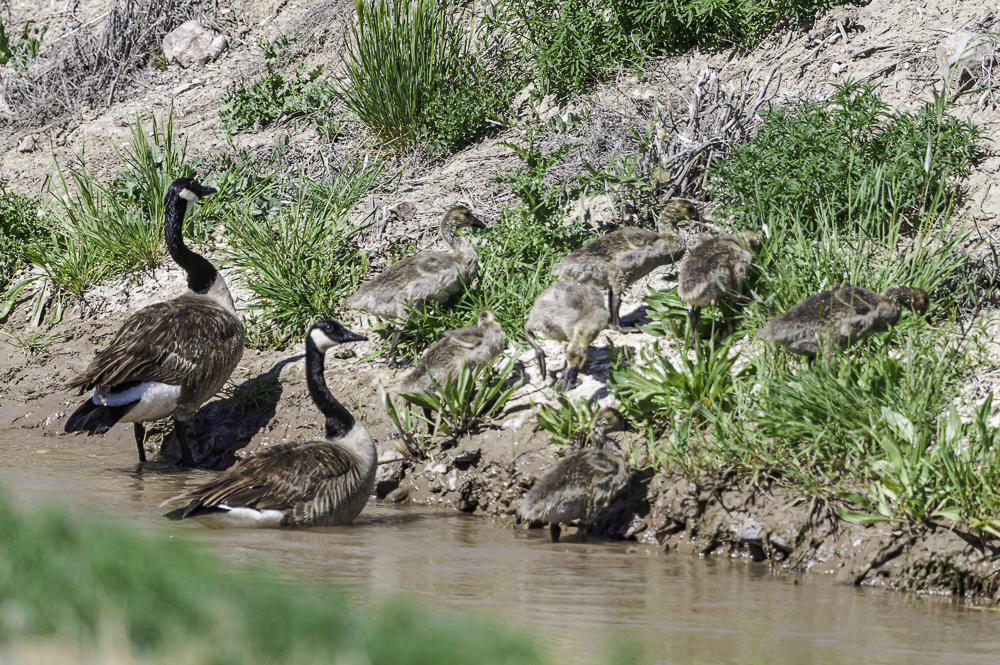
BDA Landscapes
Photographers travel to BDA in the late Autumn and early Winter to photograph the Sandhill Cranes and Snow Geese, and sometimes the other birds including hawks and an occasional eagle. Some of these may notice the wonderful landscape possibilities that this Preserve has to offer. The surrounding terrain consists of farmland, hills, and low-lying mountains often dusted with snow that time of year. However, these landscapes suffer because of the lack of well-defined points of interest. That’s where the birds come in.
In 2008 I coined the term “Living Landscapes” to describe the combination of classic landscape photography and environmental portrayals of resident wildlife. This is not easy to accomplish because in most cases, the local wildlife is greatly diminished from years of habitat destruction and interruption of natural migration routes that ultimately reduce land-based wildlife populations to mere fractions of what they once were. Slowly, federal, state and local governments have developed programs to alleviate these constrictions, and are aided and guided by many wildlife support groups in their efforts.
BDA is an example of how important this work is. BDA was launched in 1939 and has made a key contribution toward maintaining healthy migrations, as well as a source of joy to those who treasure wildlife and extensive vistas in key locations with few signs of land development.
So, the resident and visiting wildlife are abundant there and provide the focal points needed to capture exciting landscapes, particularly in combination with famed New Mexico lighting. The following are five Living Landscapes that I captured during my recent visit.
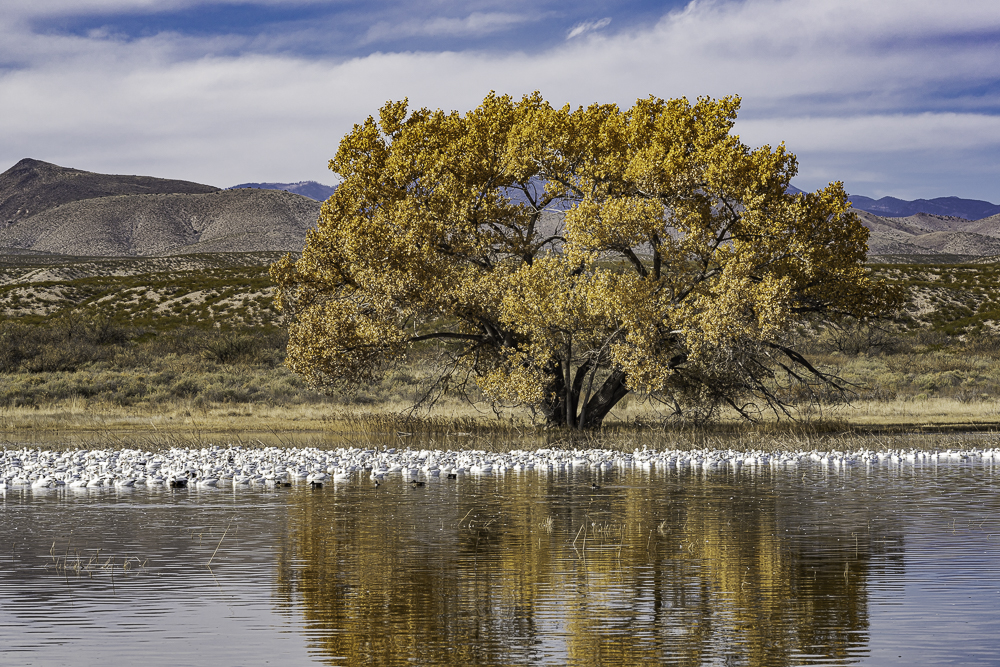
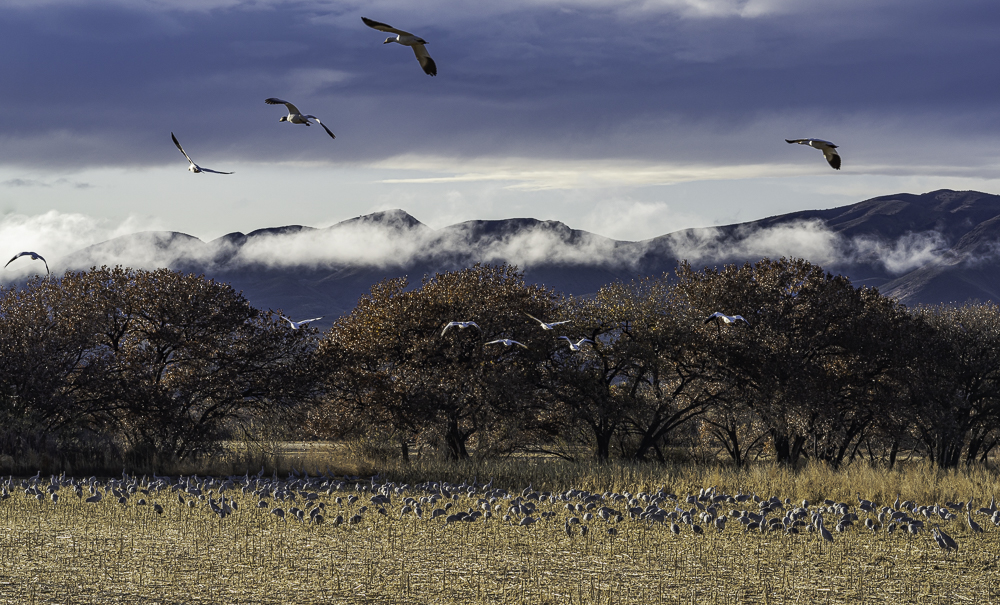
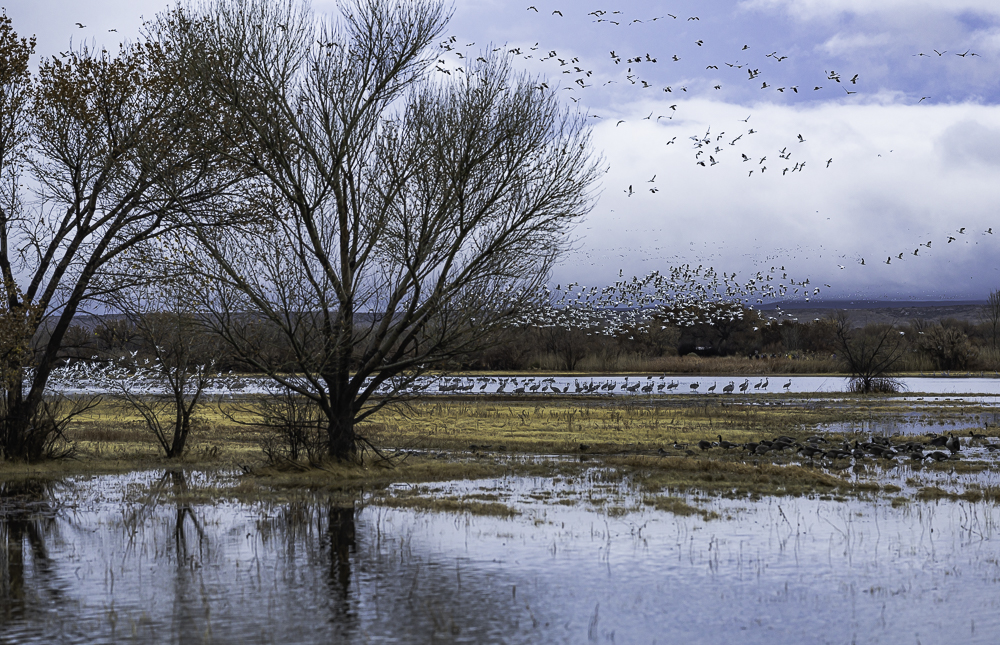
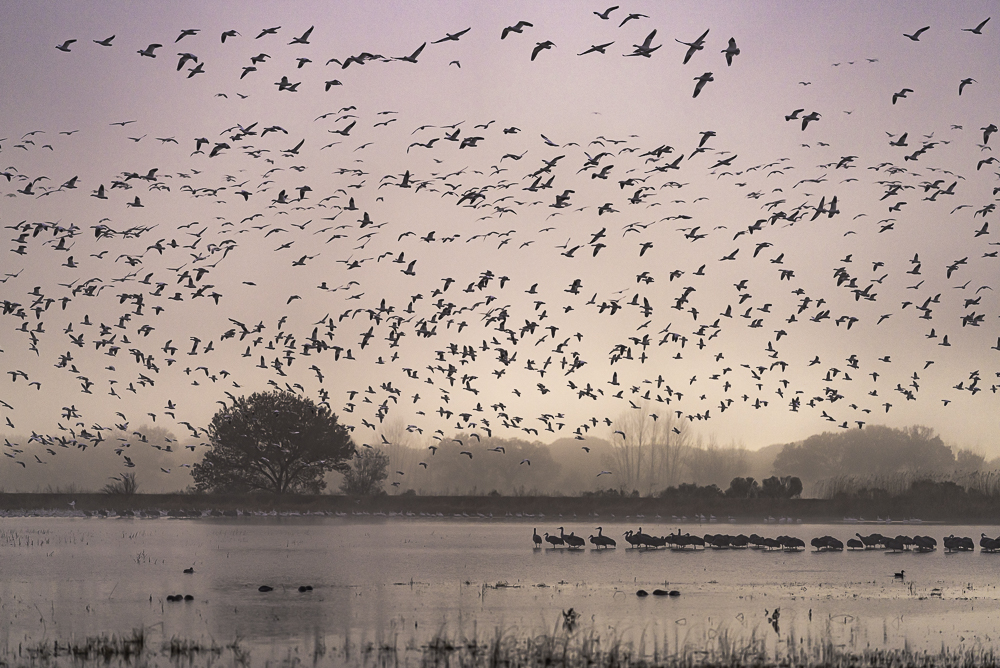
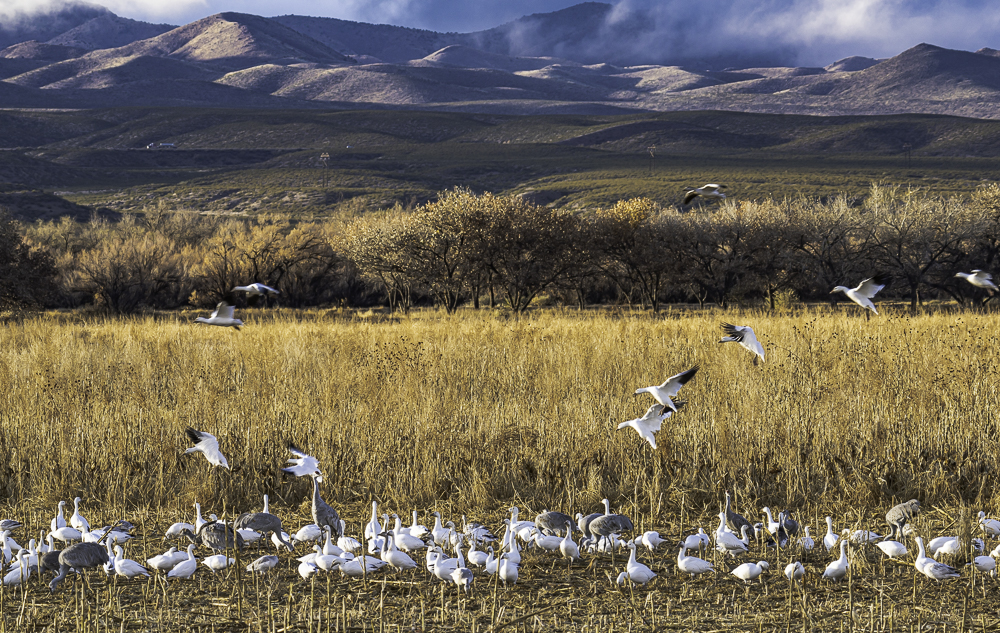
Other Wildlife
And, just as a reminder, there are other forms of wildlife worth photographing at BDA.
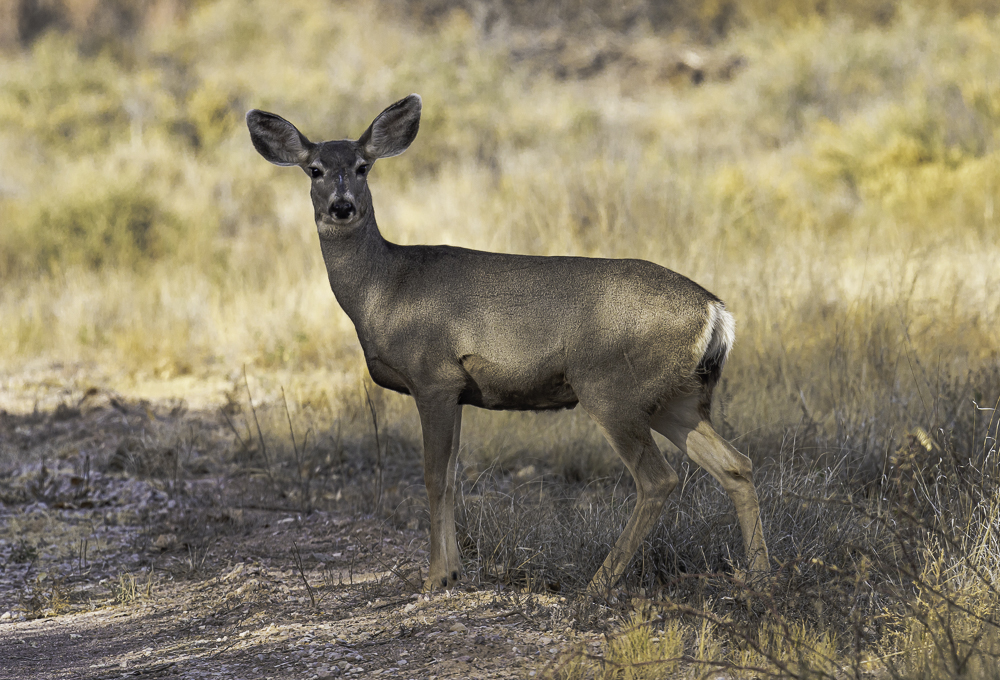
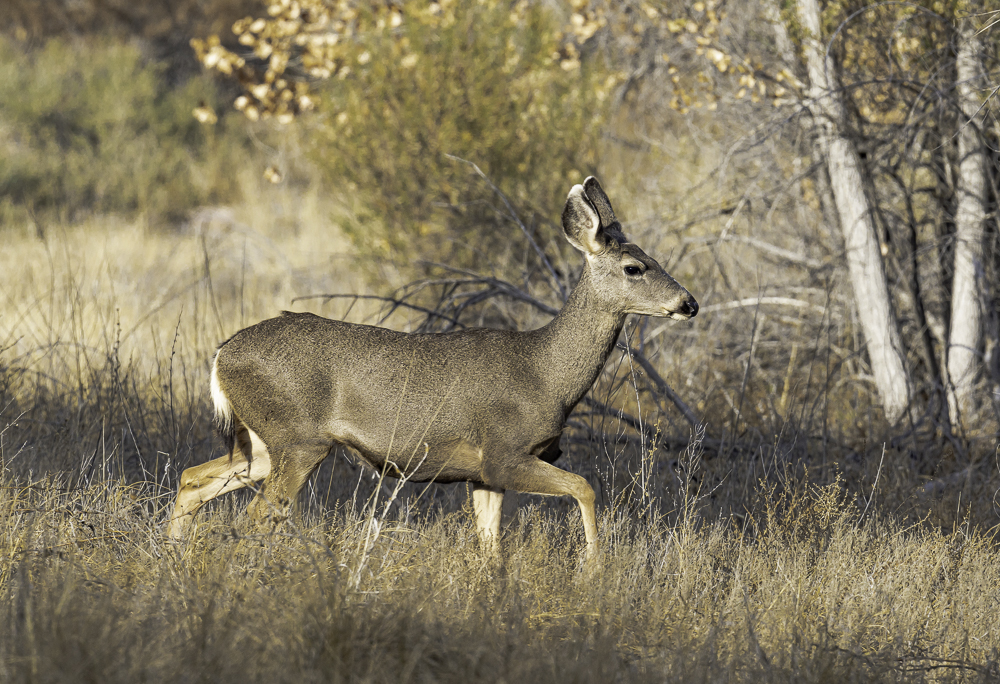
Final Words
Words and even photographs can’t fully capture the experience of a beautiful natural environment full of living creatures and the air alive with their sounds of exuberance. As a lifelong still photographer, my instinct is to see and capture images one at a time with the anticipated joy of seeing crisp detail of what I experienced. Yet, a good video would have captured what I saw and heard better; and it only required a simple click of the video button on my Sony camera. Well, that’s another compelling reason to visit New Mexico again – soon!
If you like this article please check out some of Harvey’s other articles. . .
Dramatic Skies for More Compelling Landscapes
The Benefits of Regular Image Inventory Management (IIM)
Western Mountain Landscape Photography
Harvey Stearn
January 2020
Sedona, AZ
To see the scope and essence of Harvey Stearn's photographic art please visit www.CameraStops.com. Mr. Stearn began photographing Western landscapes and wildlife at the age of 13, spent 50 years pursuing his passion in the field and in the darkroom before fully converting to digital photography in 2002. He developed color prints as well as monochrome, but switched over to digital capture and editing in 2002. Though he was a top executive for two large scale land development and home building corporations, he always found time for his fine art photography which won many awards. His work was exhibited in art museums in Southern California and Arizona, and was also featured in billboard advertisements and published in magazines. Mr. Stearn served on the California Arts Council for nine years, including two years as Chairman and another two as Vice Chairman. In addition, he was the founding Chairman of the John Wayne Airport Arts Commission in Orange County, California. Mr. Stearn’s work was sold through Arizona galleries for 15 years. In recent years he wrote 33 illustrated articles for PhotoPXL.com and 14 articles for Luminous-Landscape.com. In 2013 he published a book entitled “In Search of the Old West” which has been widely acclaimed. He was a guest lecturer on photography on a cruise ship visiting Chile, Argentina, Uruguay and the Falkland Islands. His work was among the top 100 images printed in NANPA's Showcase publications in 2019 and 2020. Images have been edited and selected for two new books on Landscape photography which will be published in late 2024 and early 2025.






